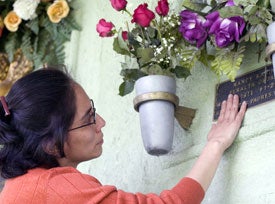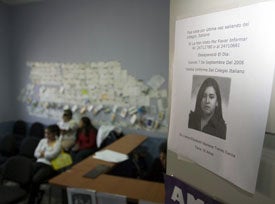News
Murder and Mutilation Stalk the Women of Guatemala
- 22 November 2006
News
GUATEMALA CITY, Guatemala— Above Guatemala City morgue and forensic medical service, clouds of vultures circle and dip. The smell of death and cleaning chemicals hits visitors with the force of a hammer. In Guatemala, a country that is still struggling to emerge from under the shadow of more than three decades of civil war, an estimated two women a day die a violent and often gruesome death. And the number of murdered females is steadily rising: 494 in 2004, 665 last year, and, as of 5 November, 516 and counting. Many of the victims have been mutilated and raped. For a country of 12 million, the numbers are alarming and surpass by far those of the better-known murders of women in Ciudad Juarez, Mexico.

Speaking about the dismembered corpses, Doctor Mario Guerra says, “We see those often.” The coroner’s open, red pick-up truck brings in the bodies – many of which have been dumped throughout the city – in ditches, alleyways, parks and the city dump. Some of the corpses remain unidentified. Those are posthumously christened XX (Jane Doe) and buried at Verbena, the public graveyard next door.
Although the level of violence in Guatemala is high for both sexes, and more men than women are killed every year, women’s groups point out that women and girls are often killed because of their gender – raped, dismembered or murdered during domestic disputes or by gangs knows as maras(gangs of criminal youth). “These murders are carried out with such viciousness that it makes them stand out from other crimes,” says Nadine Gasman, UNFPA Representative for Guatemala.
Women’s groups use the Spanish-language term feminicido – female genocide – to describe the growing tide of violence, murder, rape and mutilation of women that is now sweeping across this Central American country.
Some of the murders display a shocking level of violence. The murder of Nancy Peralta, a 30-year-old accounting student who was abducted from the San Carlos University in Guatemala City is a case in point. Nancy was abducted and killed on 1 February 2001. Family members found her three days later at the city morgue where she had been admitted as yet another ‘XX’. Her throat had been slit and 48 stab wounds punctured her torso, legs and arms.
Nearly five years later, her family is still hoping that her killer may be caught and brought to justice. Nancy’s sister, Maria Elena Peralta (34), followed the investigation from its beginning, and has now dedicated her life to helping other victims and their families at the Survivors’ Foundation, a government-funded group that works to protect the legal rights of victims and their families. The Foundation also offers psychological and medical care.
"The deterioration of our society is even more worrisome than the deaths. What kind of a future awaits our young people, if they internalize these values?"
--Alba Maldonado
Her family’s attempts to find justice for Nancy have been blocked by stonewalling, official indifference and downright disrespect. Maria Elena says her family provided the Public Ministry – the office responsible for investigating and prosecuting crimes – with several leads that they believed relevant to her sister’s case. “But instead of investigating the leads, they started investigating us, her own family,” she recalls. Public Ministry officials also claimed that the victim had brought on her own misfortune by being a “gang member and a whore”. Public Ministry officials declined to be interviewed for this article on the grounds that the relevant officials were on vacation.
Back at the city morgue, forensic doctors labour among the dead with little assistance from modern technology. The morgue has access to a laboratory, but no DNA testing facilities exist in Guatemala. Critics charge that forensic investigations are often sloppy, and the official cause of death is frequently inaccurate and misleading. In most cases, the victims’ clothing, which is often the most valuable and only source of evidence, is either burned or handed back to the family. Too often, local authorities attribute the cause of death to gunshot wounds, while evidence of torture goes undocumented. In a number of instances, the police or pathologist have even ascribed the wrong gender to murder victims.
It is difficult, if not impossible, to pinpoint a single cause for the femicide in Guatemala. Domestic violence, drugs and gangs are only one aspect of a much broader picture. Forensic studies have identified the maras' calling card: dismembered, often female, corpses left at the scene. But while the media has focussed primarily on those killings that bear the maras' unmistakeable signature, activists also point the finger at an undercurrent of corruption and abuse of power among the authorities themselves. All of this, coupled with the low status of women in the Guatemalan society, add up to a lethal mix.

It was a police officer who shot and killed Santos Marlen Flores, a 32-year-old mother of three, in her own home outside of Guatemala City. The officer was angry because Marlen’s half brother had fallen in love with his wife. The pair decamped together last June – leaving Marlen to face down the officer’s rage. One day he arrived at the family house demanding to know the couple’s whereabouts, which Marlen did not know. Angry and frustrated, the police officer returned a few days later and shot her four times. After struggling to stay alive for three weeks, Marlen died. In this case, unlike so many others, the justice system seems to be working: the police officer is in custody, awaiting trial.
Not all of the violence meted out to Guatemala’s women ends in death – thanks, in part, to the Survivors’ Foundation. On 4 October, 15-year-old ‘Ana’ was on her way to school when two men grabbed her by the arms. They forced her onto a bus and took her to the infamous Pavón prison, an overcrowded jail that, until recently, had the dubious distinction of being controlled by its 1,500 inmates.*
The two men, who identified her by a photo they were carrying, told her that her uncle, a gang member going by the nickname ‘Smiley’ had sent for her. At about 9 a.m. she was led through the gates of the prison to a section where mareros, or gang members, serve their sentences. The men who had brought her left as soon as they had dropped her off.
Once inside the prison, she was met by Smiley who chatted with her for a while, then started smoking marijuana. More prisoners came to join them, and soon they demanded that Ana remove her clothes. Then they started raping her. When she screamed, they put a rag in her mouth. Six hours later, she had been raped by 21 prisoners.
For Ana, this was the latest chapter in a three-year nightmare of sexual abuse. She had been coerced into having sex several times a week with gang members who lived in her neighbourhood. They told her they would kill her entire family if she said anything: first her mother, then her sisters, then her grandfather. She would be the last one to go, and it was she, they reminded her, who would suffer the most.
Now Ana is living in a safe house run by the Survivors’ Foundation at a secret location in Guatemala. Norma Cruz, Director of the Foundation notes that Ana’s case will receive a great deal of attention when it goes to court, because it potentially implicates high-ranking officials both in the police and prison system. “People in Guatemala receive the wrong messages about violence,” she says. “It is seen as acceptable, and the impunity tells people that they can go ahead and repeat the crimes.”
“The problem is so complex that it is almost impossible to pick a single factor that would help improve the justice system, but if I had to pick one it would be the investigation procedure,” says Mirna Ponce, a member of the Guatemalan Congress, who represents the conservative Guatemalan Republican Front.
Alba Maldonado, head of the leftist Guatemalan National Revolutionary Unity party, member of Congress, and principal author of a study exploring the killing of women in Guatemala, says the violence is rooted in the country’s 36-year civil war, which ended in a peace agreement in 1996. As with most countries recovering from civil war, the killing goes on long after the fighting has stopped.
“Two hundred and fifty thousand people died during those years, she says. "There was never an investigation which led to the capture and punishment of assassins and torturers. Those people are out on the street, in government positions, and at all levels of power.”
About 97 per cent of murder cases are never solved. UNFPA is now buttressing efforts both within the Guatemalan government and civil society to tackle the situation. These efforts include support to an inter-sectoral commission headed by the Presidential Secretariat for Women, which will, among other thing, propose legal reforms. Support also includes plans to offer legal assistance to families of murder victims through a civil society organization.
“The deterioration of our society is even more worrisome than the deaths. What kind of a future awaits our young people, if they internalize these values?” Maldonado asks.
***
* On October 24, Pavón was raided by 3,000 soldiers and police armed with teargas, armoured cars and assault rifles. Inmates were moved to another prison.
{C}
{C}
Contact Information:
Trygve Olfarnes
Tel.: +52 55 5250-7977
Cell Phone: + 52 1 55 1353-8451
Email: olfarnes@unfpa.org
Patricia Leidl
Tel.: +1 (212) 297-5031
Cell Phone:
Email: leidl@unfpa.org